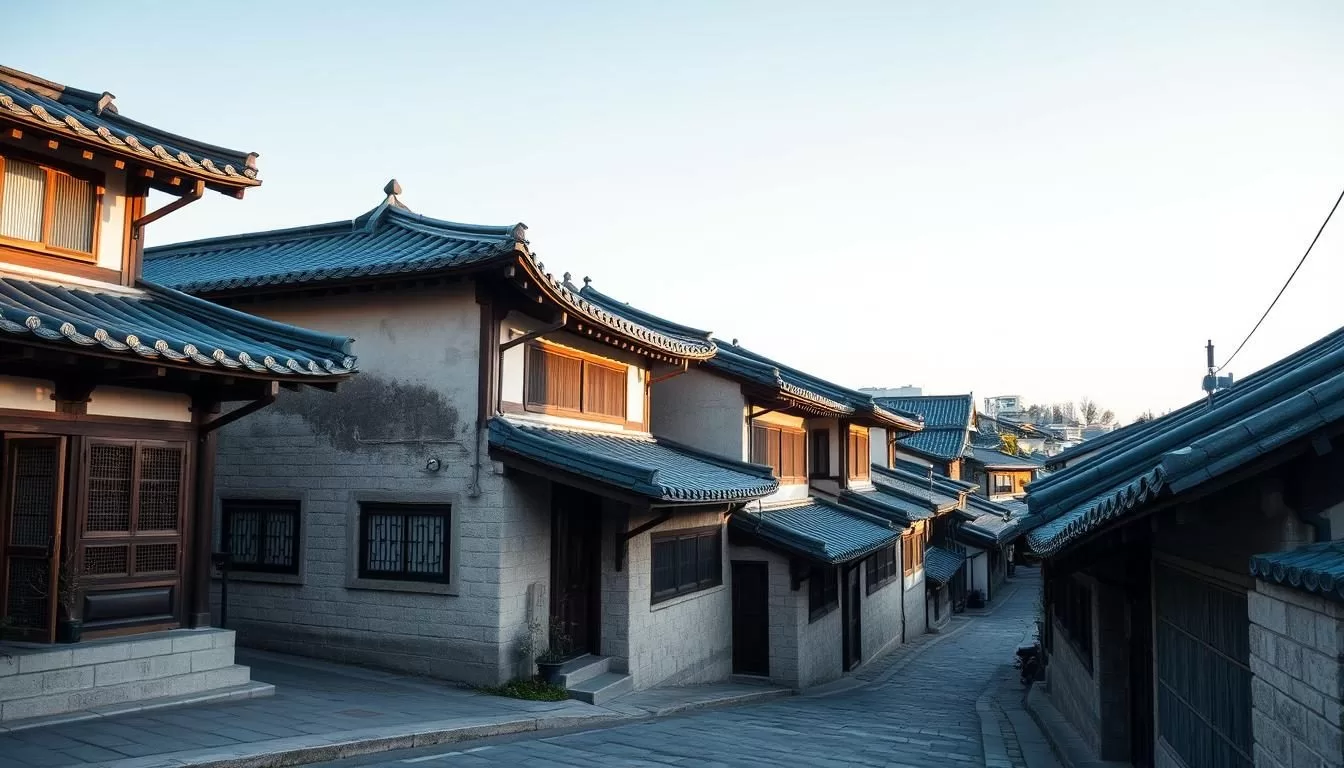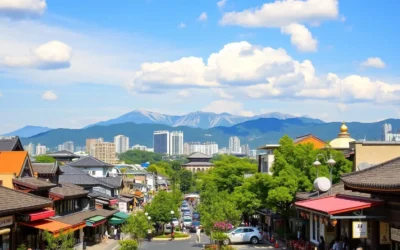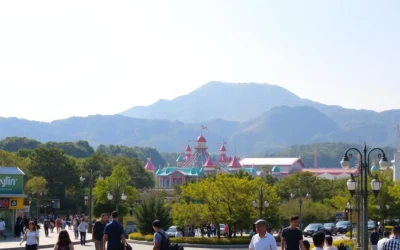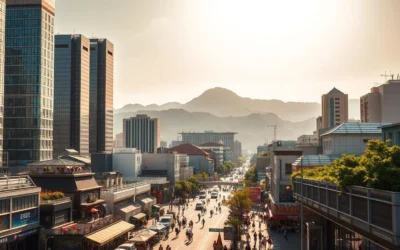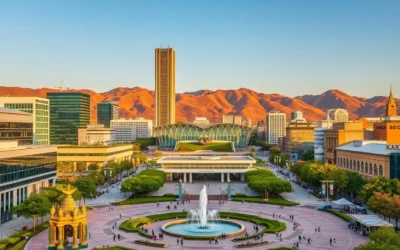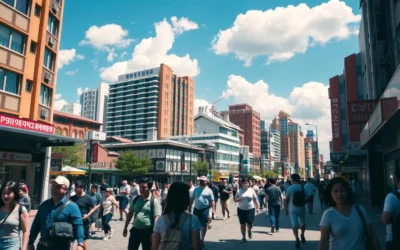Nestled in the heart of Seoul, this historic area offers a captivating blend of traditional Korean charm and modern vibrancy. With over 900 hanok houses dating back to the Joseon Dynasty, it’s a living testament to the city’s rich heritage. Today, it remains a bustling residential neighborhood, welcoming millions of visitors each year.
Located just a short walk from Anguk Station (Line 3, Exit 2), this area is easily accessible and perfect for a 2-3 hour exploration. Wander through narrow alleys lined with tiled roofs, and discover trendy cafes and restaurants alongside cultural workshops. Whether you’re snapping photos or immersing yourself in local culture, every corner tells a story.
Remember, this is a living neighborhood, so respect the residents as you explore. From historic landmarks to modern hotspots, this area promises an unforgettable experience for every visitor.
Discover the Charm of Bukchon Hanok Village
Step into a world where history and culture come alive in every corner. This area, once home to royalty and aristocrats during the Joseon Dynasty, has evolved into a vibrant neighborhood that blends the past with the present. Its narrow alleyways and tiled roofs tell stories of a bygone era, while modern cafes and workshops add a contemporary touch.
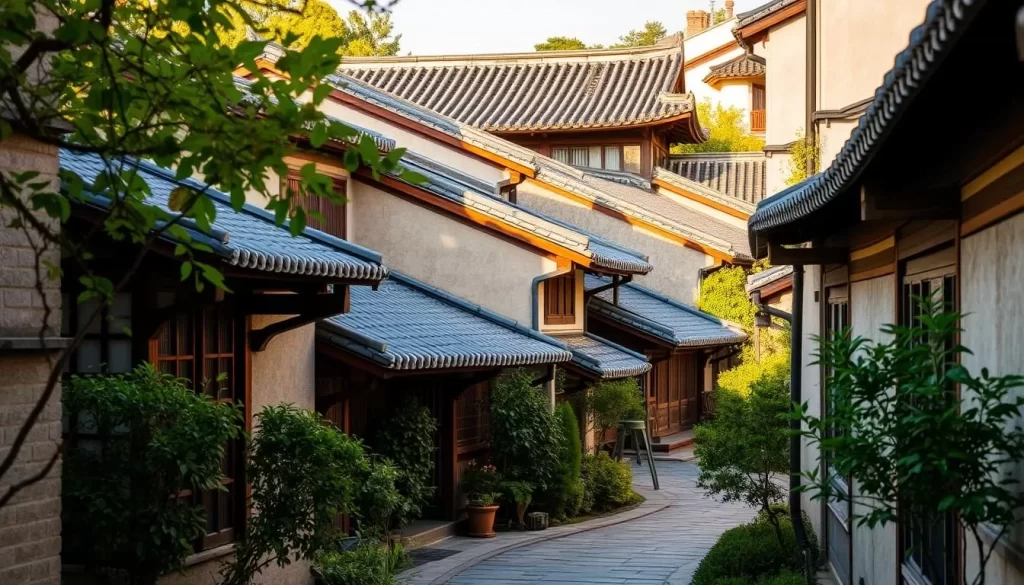
History and Cultural Significance
Originally a residential area for the elite, this district has deep roots in Korean heritage. During the Joseon Dynasty, it was a hub for the aristocracy, and its legacy is still visible today. The area began to transform in the 1930s, but its traditional essence remains intact. Today, it’s a living museum where you can experience the culture and history of Korea firsthand.
Located in Jongno-gu, this neighborhood is surrounded by iconic landmarks like Gyeongbokgung and Changdeokgung Palaces. A visit here is not just a walk through history but also a chance to connect with the local way of life. Don’t forget to pick up a map or guide to make the most of your exploration.
Architectural Beauty of Traditional Hanoks
The traditional Korean houses, or hanoks, are the heart of this area. Built with Korean red pine and designed to harmonize with nature, these structures are a testament to timeless craftsmanship. From the curved tiled roofs to the wooden beams, every detail reflects the elegance of Korean architecture.
Over the years, these houses have been preserved and adapted, offering a glimpse into the past while serving as homes, cafes, and cultural spaces. As you wander the streets, you’ll notice how the hanok design seamlessly blends with the surrounding landscape, creating a serene and picturesque atmosphere.
Bukchon Hanok Village, South Korea: Best Things to Do – Top Picks
Discover a place where every corner tells a story of tradition and innovation. This historic district is a treasure trove of must-see attractions and photo spots that capture the essence of Korean heritage. From scenic views to cultural landmarks, there’s something for every visitor to enjoy.
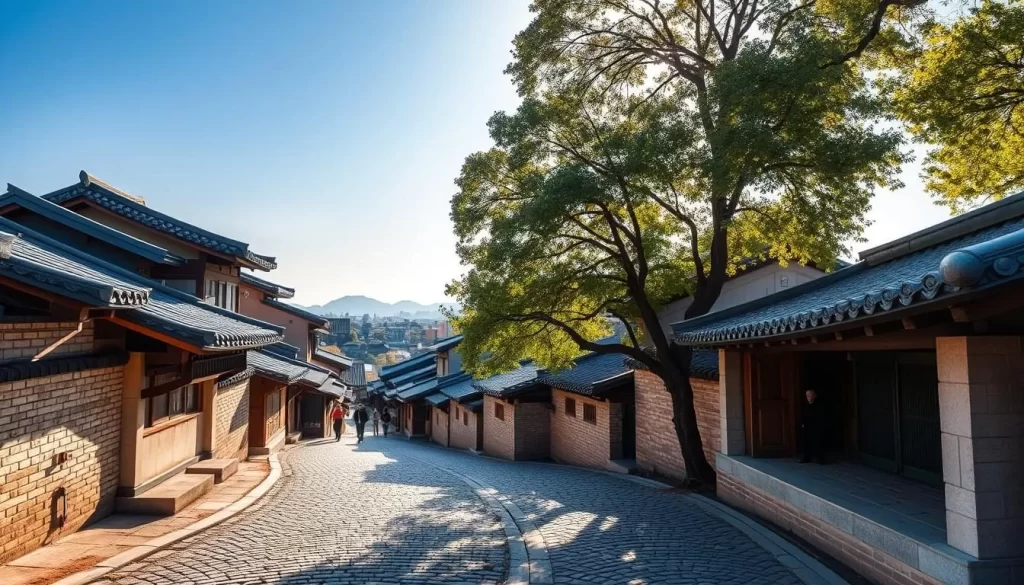
Must-Visit Attractions and Photo Spots
For the best photos, start your walk from Anguk Station exit 2. Head onto Bukchon-ro and turn into Bukchon-ro 11-gil. This stretch offers a stunning view of N Seoul Tower and is one of the most photographed spots in the area.
Another iconic stop is the Gahoe Museum, where you can explore traditional Korean art. The entrance fee is 5,000 won (~3.70 USD), and you can even take a class to create min-hwa paintings for 12,000 won (~8.90 USD).
Don’t miss the Dong-Lim Knot Museum, which opened in 2004 and offers workshops for 12,000 won (~8.90 USD). It’s a great place to learn about traditional Korean crafts.
Respecting the Residential Community
While exploring, remember that this is a living neighborhood. Keep your voice down and avoid intruding on private spaces. Respecting the residents ensures that everyone can enjoy the area’s beauty.
Follow local guidelines and stick to designated paths. This helps preserve the charm of the place for future visitors.
| Attraction | Highlights | Cost |
|---|---|---|
| Gahoe Museum | Traditional art, min-hwa painting classes | 5,000 won (~3.70 USD) |
| Dong-Lim Knot Museum | Traditional crafts, workshops | 12,000 won (~8.90 USD) |
| Bukchon-ro 11-gil | Scenic views, photo spot | Free |
Plan your tour to combine sightseeing with responsible photography. This way, you can fully experience the unique blend of history and modern trends that make this place so special.
Explore Traditional Experiences and Tours
Immerse yourself in the heart of Korean tradition with hands-on activities that bring history to life. From dressing in traditional attire to joining cultural workshops, this area offers a unique way to connect with the past. Whether you prefer a guided tour or self-exploration, there’s something for everyone to enjoy.
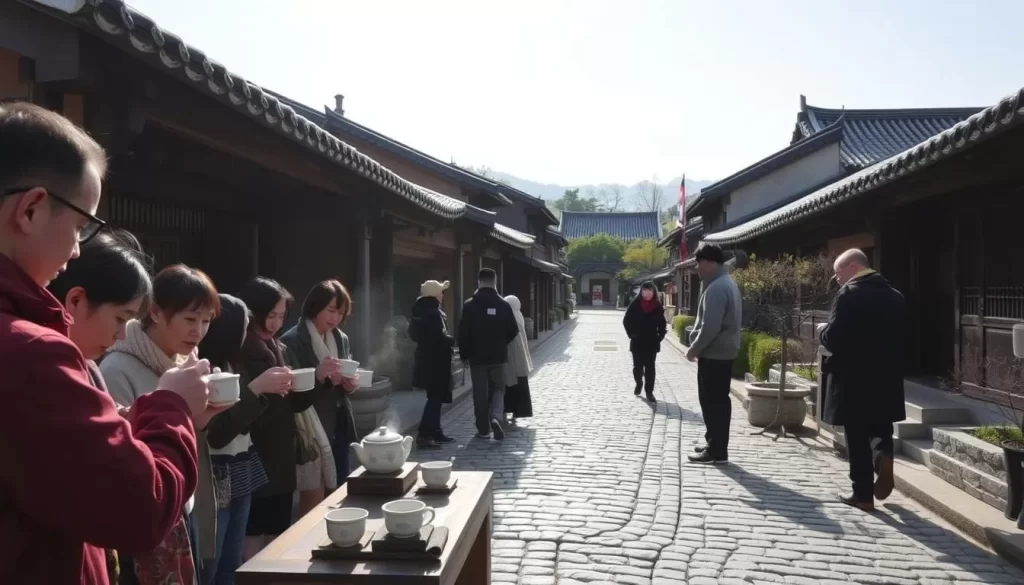
Hanbok Rentals and Cultural Workshops
One of the most popular activities is renting a hanbok, the traditional Korean attire. Shops along Bukchon-ro and Gyedong Gyedong-gil offer a variety of styles, allowing you to step into the shoes of a Joseon-era aristocrat. Pair your outfit with a visit to a cultural workshop, where you can try your hand at traditional crafts like knot-making or min-hwa painting.
These workshops are led by local artisans, providing an authentic and personal experience. It’s a chance to learn about Korean culture while creating something meaningful to take home.
Guided Walking Tours and Self-Exploration
For a deeper understanding of the area, consider joining a guided walking tour. Knowledgeable guides share fascinating stories about the history and architecture of the traditional hanok houses. Tours often include hidden gems and lesser-known spots that you might miss on your own.
If you prefer to explore at your own pace, grab a map and wander the charming streets. The area is best experienced on foot, with plenty of photo opportunities and quiet corners to discover. Remember to respect the residential nature of the neighborhood as you explore.
Whether you choose a guided tour or self-exploration, these experiences offer a rich and immersive way to connect with Korean heritage. Plan your visit during weekdays to avoid crowds and make the most of your time.
Savor the Flavor: Cafes and Restaurants in Bukchon
Step into a culinary haven where traditional flavors meet modern innovation. This area is a paradise for food lovers, offering everything from cozy cafes to Michelin-approved restaurants. Whether you’re craving a cup of coffee or a gourmet meal, there’s something to satisfy every palate.
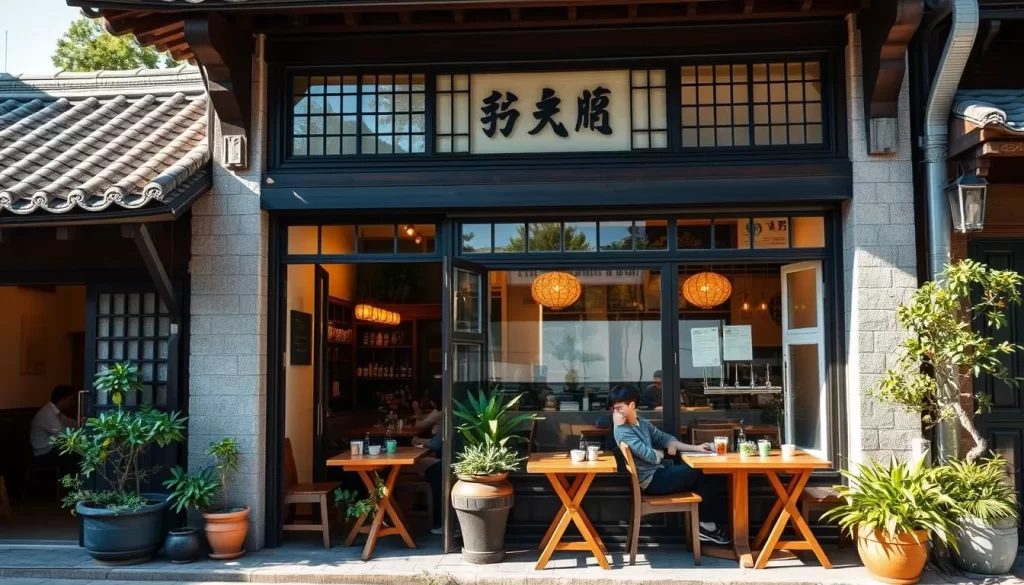
Trendy Cafes and Michelin-Approved Eateries
Start your day at Onion Anguk, a popular spot known for its artisanal pastries and long queues. Arrive early to secure a table and enjoy the serene courtyard setting. Another must-visit is Cafe Layered, where you can indulge in freshly baked scones and a variety of teas. The cozy interiors make it a perfect stop for a relaxing break.
For a Michelin-approved experience, head to Hwangsaengga Kalguksu. This Bib Gourmand restaurant is famous for its handmade noodles and dumplings, offering a taste of authentic Korean cuisine. Don’t forget to try Oreno Ramen, another Bib Gourmand selection, known for its simple yet flavorful ramen dishes.
Unique Korean Dining Experiences
Explore the blend of tradition and modernity at Knotted Anguk, where you can enjoy unique desserts in a hanok-inspired space. The use of technology, like the Catch Table app, makes ordering seamless and efficient. For a more traditional experience, visit Kkangtong Mandu, a local favorite known for its dumplings and noodles, recognized in the Blue Ribbon Survey since 2014.
Take a leisurely walk along Yulgok-ro and discover hidden gems like London Bagel Museum. Be prepared for long queues, but the freshly baked bagels are worth the wait.
| Venue | Specialty | Highlights |
|---|---|---|
| Onion Anguk | Pastries | Serene courtyard, early arrival recommended |
| Cafe Layered | Scones and Tea | Cozy interiors, perfect for relaxing |
| Hwangsaengga Kalguksu | Handmade Noodles | Bib Gourmand, authentic Korean cuisine |
| Oreno Ramen | Ramen | Bib Gourmand, simple yet flavorful |
| Knotted Anguk | Desserts | Hanok-inspired space, Catch Table app |
| Kkangtong Mandu | Dumplings | Blue Ribbon Survey, local favorite |
| London Bagel Museum | Bagels | Freshly baked, long queues |
Plan your visit during weekdays to avoid crowds and make the most of your time. Whether you’re snapping photos or savoring a meal, this area promises a memorable culinary journey.
Best Walking Courses and Photo Walks
Take a leisurely stroll through this iconic area, where tradition meets modernity in every detail. Whether you’re a photography enthusiast or a food lover, the walking courses here offer a unique way to explore the charm of this historic neighborhood. From scenic photo stops to gourmet food trails, there’s something for everyone to enjoy.
Classic Photo Stop Views
The Classic Course, designated by the Seoul Metropolitan Government, features eight scenic photo stops. These spots are perfect for capturing the essence of the area, with views of tiled roofs, narrow alleys, and historic architecture. Start your walk early in the morning or late afternoon for the best lighting and fewer crowds.
One of the most popular stops is along Bukchon-ro 11-gil, where you can snap a stunning shot of N Seoul Tower in the background. Another must-visit is the Unhyeongung Palace, a historic site that offers a glimpse into Korea’s royal past.
Gourmet Courses Featuring Local Delicacies
For food lovers, the Gourmet Course near Anguk Station is a treat. This route combines sightseeing with stops at local eateries, where you can savor traditional Korean delicacies. Start your journey at Onion Anguk, known for its artisanal pastries, and end at Hwangsaengga Kalguksu for a bowl of handmade noodles.
Along the way, don’t miss Knotted Anguk, a dessert spot offering unique treats in a hanok-inspired space. Use a map to navigate the route and make the most of your culinary adventure.
For more tips on exploring this picturesque area, check out this . Whether you’re snapping photos or savoring local flavors, these walking courses promise an unforgettable experience.
Plan Your Visit: Practical Tips and Timing
Planning your visit to this historic area is easier than you think, with practical tips to make your trip seamless. Whether you’re arriving by public transit or exploring on foot, these guidelines will help you navigate the area with confidence.
Navigating via Anguk Station and Public Transit
The easiest way to reach this iconic neighborhood is via Anguk Station (Line 3, Exit 2). From here, it’s just a 12-minute walk uphill to the heart of the area. If you’re coming from Incheon International Airport, take the airport limousine bus to Jongno-gu for a hassle-free journey.
Once you arrive, use a map to guide your exploration. The narrow streets can be tricky, but signs and landmarks make navigation straightforward. Remember, this is a residential area, so keep your voice down and respect the locals.
Visiting Hours, Safety, and Seasonal Guidelines
The area is open 24/7, so you can visit at any time. However, early mornings or late afternoons are ideal to avoid crowds. Plan to spend about one hour exploring, as the area is compact but rich in history.
Seasonal changes also affect your visit. Spring and autumn are peak times due to pleasant weather and vibrant scenery. Summer can be humid, while winter offers a quieter experience. Be aware of upcoming restrictions effective November 2024, designed to protect resident privacy.
For a deeper dive into Seoul’s attractions, check out this guide to planning your trip. It’s packed with tips to make your visit unforgettable.
- Use Anguk Station (Exit 2) as your starting point.
- Arrive early or late to avoid peak crowds.
- Respect the residential nature of the area.
- Check for seasonal guidelines and restrictions.
Hidden Gems and Off the Beaten Path
Venture beyond the main streets to uncover the quiet charm of hidden alleys and local art. While the popular spots are worth visiting, the true magic lies in the lesser-known corners. These areas offer a more intimate experience, away from the bustling crowds.
Take a walk down Gyedong Gyedong-gil, a quiet alley lined with boutique shops and art installations. Here, you’ll find unique photo opportunities that capture the essence of local culture. The side streets are perfect for those who want to explore at their own pace.
For a deeper connection to the area, visit the smaller traditional hanok houses tucked away from the main routes. These homes, still inhabited by residents, offer a glimpse into daily life. Respect their privacy as you admire the architecture and serene views.
Don’t miss the local art displays scattered throughout the quieter alleys. These installations add a modern touch to the historic surroundings. They’re a testament to the area’s evolving culture and creativity.
Exploring these hidden gems allows you to see a different side of this historic place. For more inspiration on underrated spots, check out this guide to underrated places in Seoul. It’s a great way to enhance your journey and discover even more unique treasures.
Nearby Attractions and Authentic Accommodations
Explore the vibrant surroundings of this historic area, where culture and tradition meet modern convenience. Beyond the main streets, you’ll find iconic landmarks and unique stays that make your visit unforgettable. From grand palaces to cozy guesthouses, there’s something for everyone to enjoy.
Palaces, Museums, and Cultural Centers
Start your journey at Gyeongbokgung Palace, a stunning example of Joseon Dynasty architecture. Just a short walk away, Changdeokgung Palace offers serene gardens and a glimpse into royal life. Both palaces are must-see attractions for history enthusiasts.
For a deeper dive into Korean culture, visit the Bukchon Traditional Culture Center. Open seven days a week, it’s a great place to learn about local traditions and crafts. Nearby, the Gahoe Museum showcases over 2,000 folk paintings and craftworks, offering a unique cultural experience.
Stay in a Traditional Hanok or Boutique Guesthouse
For an authentic experience, consider staying in a traditional hanok. These houses blend historic charm with modern amenities, offering a unique way to immerse yourself in the local culture. Some accommodations, like the Exclusive Penthouse with Great Hanok Village View, provide stunning views of the area.
Boutique guesthouses, such as Hwadong 1Beonji, offer a cozy and personalized stay. Many of these options are located in Jongno-gu, making it easy to explore nearby attractions. Keep in mind that traditional stays may involve sleeping on the floor, which might not suit everyone.
For more travel inspiration, check out this guide to South Korea. It’s packed with tips to enhance your journey.
| Accommodation | Highlights | Location |
|---|---|---|
| Exclusive Penthouse | Stunning views, modern amenities | Jongno-gu |
| Hwadong 1Beonji | Cozy, personalized stay | Jongno-gu |
| Traditional Hanok | Historic charm, cultural immersion | Jongno-gu |
Plan your visit to include both cultural exploration and a comfortable stay. Whether you’re touring palaces or relaxing in a hanok, this area promises a memorable experience.
Conclusion
This historic area offers a perfect blend of tradition and modernity, making it a must-visit for every visitor. From its scenic views to its rich culture, there’s something for everyone to enjoy. Whether you’re taking a guided tour or exploring on your own, the charm of this place will leave a lasting impression.
Remember to plan your visit during weekdays to avoid crowds and make the most of your time. Respect the residential nature of the area as you wander through its narrow alleys and capture stunning photos. With its unique blend of history and modern attractions, this place promises an unforgettable experience.
For more inspiration on exploring Seoul’s vibrant offerings, check out this guide to the city’s best experiences. Start planning your trip today and immerse yourself in the living traditions of this iconic neighborhood.
The above is subject to change.
Check back often to TRAVEL.COM for the latest travel tips and deals.
Here are some Tours & Sightseeing suggestions that might pique your interests!
